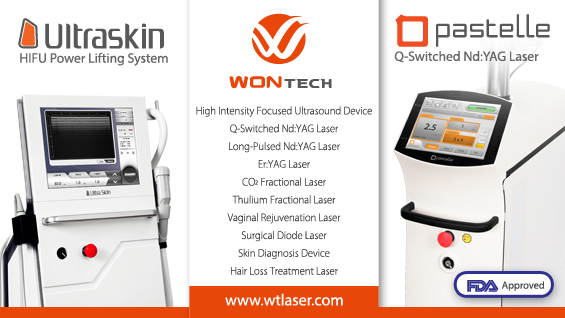
Oh Wook, Director of Samsung Feel Clinic
The thulium laser’s chromophore being water may be a limitation in pigmented lesion treatment. However, this can also mean that the thulium laser does not act selectively on certain pigments, which allows it to target various types and colors of pigments if the target layer is carefully selected.
We have compared the characteristics of the thulium laser with 1550nm and 10600nm lasers. Let’s take a look at Lavieen’s unique advantages over other thulium lasers.
The most noticeable advantage of Lavieen is that parameters can be more closely adjusted according to the demands and objectives of a given treatment. Unlike early thulium lasers with only pulse duration adjustment, Lavieen allows adjustment of the pulse duration, wattage, distance between fractional beams, and irradiation patterns, etc. On top of these features, Lavieen also boasts the stacking mode where two laser irradiations are given consecutively and continuous laser mode which allows continuous laser irradiation through a moving handpiece. Lavieen allows many different techniques and patterns that each doctor can choose from to satisfy various needs.
[Advertisement] Ultra Skin/Pastelle – Manufacturer: WONTECH(www.wtlaser.com)
On histological examination, all thulium lasers typically preserve the stratum corneum while coagulating the deeper epidermis and upper dermis. However, Lavieen laser has the added feature of non-ablative and subablative methods and allows a more accurate and customized treatment. That is, the user can perform mild coagulation of the upper dermis or partially ablate the dermoepidermal junction. This is the most impressive advantage of Lavieen laser.
Lavieen can largely be used in three types of treatments; 1) mild toning for whitening effects, 2) more aggressive treatment using the stamp technique, and 3) selective ablation of pigmented lesions.
First, the toning technique has short downtime and causes mild pain. It does not cause the lattice pattern on the skin. The pulse duration can vary from 400μs to 1,500μs. The handpiece can be moved during continuous irradiation at 10W, distance 0.9mm, Overlap 0, and continuous mode. The treatment typically continues until small wheal or marked erythema appear over the entire face.
Second, the stamp technique allows irradiation of even energy over the entire face. The irradiation line is overlapped once or twice. Up to 60,000-80,000 shots are given in a single treatment of the entire face.
The third treatment selectively removes the target pigmented lesions. It can follow the above two methods or can be performed alone for local removal of pigments. The pulse duration is slightly longer than the other two methods and the energy level is lowered to 5W. The laser is irradiated only on the target lesion and continued until the lesion turns taupe or light brown in color.
Lavieen laser offers the user a wide variety of applications and indications depending on his/her skills and needs. It has both the non-ablative and subablative methods and targets the dermoepidermal layer while leaving the stratum corneum intact. It can be used not only in pigmented lesions but general skin tone correction.

Lavieen Laser.
-The End-




















